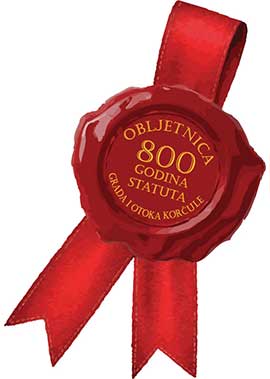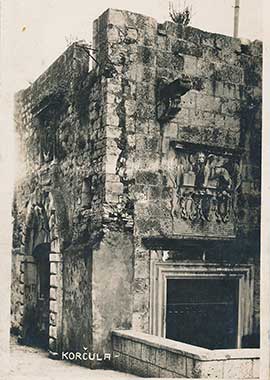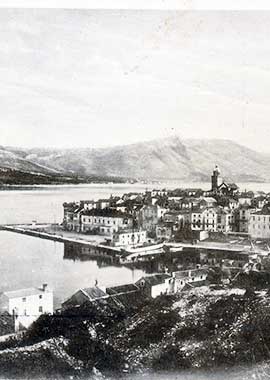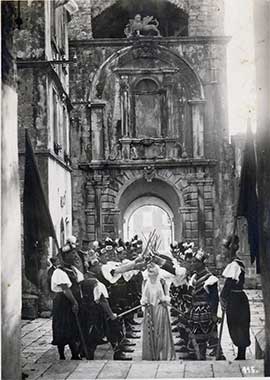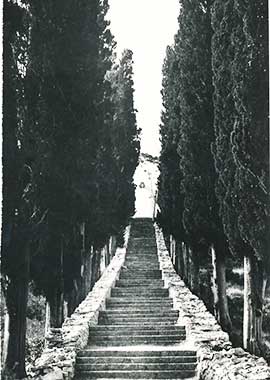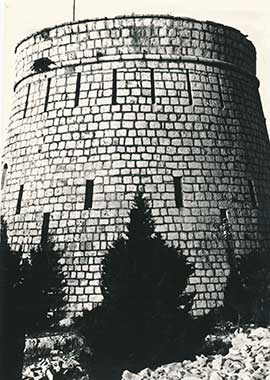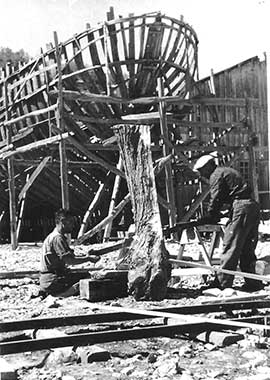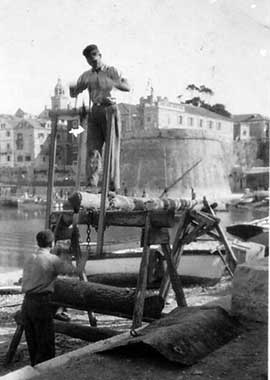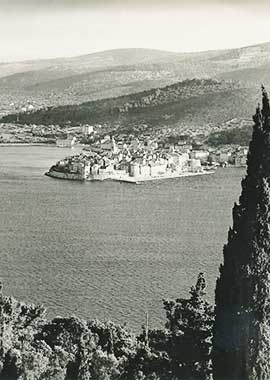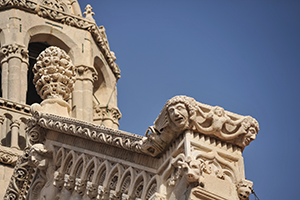Above the entrance of the Land Gate, there are two symbols marking Korčula's history:
- - a bas-relief with the winged lion of St. Mark, symbolizing the reign of the Venetian Republic,
- - and a stone tablet commemorating the 1000th anniversary of the coronation of the first Croatian king, Tomislav.
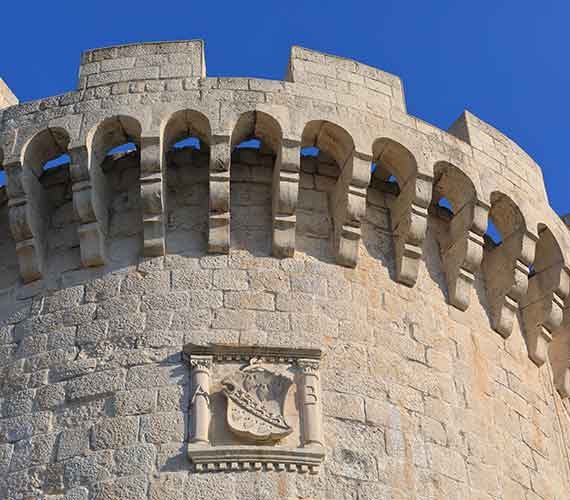
3RD-2ND MILL. B.C.
Rich finds from caves, and especially from Vela špilja in Vela Luka, witness the development of the Neolithic culture and its maritime links with other parts of the Mediterranean.
2ND-1ST MILL. B.C.
Illyrian tribes inhabit the island, from whom "gradine", fortifications on the hills, graves, and other archeological finds have been preserved.
6TH CENT. B.C.
the first Greek colony by the name of Korkyra Melaina; to differentiate it from Korkyra (present-day Corfu), the adjective Melaina (dark, black) denoted an island completely covered by wood.
4TH CENT. B.C.
The second Greek colony with the still extant "psephisma from Lumbarda". This stone tablet describes the decision of the assembly to found and build the town, to divide the land among the settlers, and confirms the agreement for peaceful coexistence with the Illyrian inhabitants.
4TH CENT. B.C.
This inscription, found at Lumbarda, is the oldest written document on Croatian territory and is now housed in the Archaeological museum in Zagreb.
229 B.C.
Corcyra Nigra or Black Korčula - comes for the first time under Roman rule. The peace is disturbed at times by the successful pirate campaigns of the Illyrian tribes in Dalmatia, who make war against Rome with varying success.
34-35 B.C.
The Roman military leader Octavian - later the emperor Augustus - attacks Illyrian Korčula, occupies it and kills or sells as slaves all the inhabitants of the island. The Illyrian state ceases to exist at the time of the Emperor Augustus, and the eastern coast of the Adriatic becomes part of the Roman province of Illyricum.
476.
At the fall of the Western Roman Empire, Korčula comes under the reign of Theodoric, king of the Eastern Goths, in 480.
5TH CENT.
The ancient Christian church on the islet of Majsan is the earliest proof of Christianity in Korčula.
535.
Korčula within the province of Dalmatia comes under the reign of Byzantium at the time of the emperor Justinian.
8TH CENT.
The beginning of the settling of the Neretvans, a Croatian tribe, on the island of Korčula, which is given the name of Krkar.
945.
The Byzantine Emperor Constantine Porphyrogenitus writes about Croatian Krkar on the island of Korčula.
948.
The Venetians pay dues to the Croatian kings who allow them to sail along the Adriatic coast.
1000.
The Venetian duke Petar II Orseolo conquers Korčula and a period of Venetian rule begins and lasts until 1420, interspersed with periods of reign by Croatian, Croatian-Hungarian, Zahumljan and Bosnian rulers.
1125.-1180.
Korčula is under the reign of Venice.
1254.
the Venetian nobleman Marsilius Zorzi takes Korčula under his command and confirms the Korčula Statute of 1214. This period of Venetian rule lasts until 1358.
The great Venetian traveller and explorer, Marko Polo, is born in Korčula.
07.09.1298.
The great naval battle between the Genoese and the Venetian fleets takes place in front of the town of Korčula; the Venetian fleet is defeated, and the Genoese have, among their prisoners, the great Marko Polo, who is freed on payment of a big ransom in 1299.
1300.
The foundation of the Korčula diocese.
1301.
The foundation of the Brotherhood All Saints.
1420.-1797.
The longest period of Venetian rule over Korčula.
1483.
The successful defence of Korčula from attack by the Neapolitan King Ferrante I of Aragon.
1529.
The town and the island of Korčula suffer from the Great Plague.
1637.
The best known Korčula poet and comedist of the Baroque period, Petar Kanavelić, is born (died in 1719).
1797.
The fall of the Venetian Republic to Napoleon.
1797.-1805.
Austrian rule over the island.
1805.-1813.
French rule; the building of roads and fortifications.
1806.-1807.
The attacks by the Russian fleet.
1813.-1815.
The Forteca tower on the hill above Korčula town was built by Royal Marines. Korčula is under the rule of the British Navy.
1815.-1918.
Korčula is under Austrian rule as part of the Kingdom of Dalmatia.
1828.
The Korčula diocese is nullified by the abolition of the Dubrovnik archbishopric.
19TH CENTURY
"People's Revival in Dalmatia"; political life in Dalmatia, and thus in Korčula, is characterized by the struggle for the unification of Dalmatia with Croatia; the concept of a national Croatia and the concep of "autonomaši", confflicts with Italian national interests in Dalmatia.
1871.
After local elections the commune of Korčula passes into Croatian hands; the following years witness the foundation of Croatian cultural societies; the teaching of the Croatian language progresses etc.
19TH CENTURY
Korčula lost much of its strategic importance with the decline of Venice and the decline of traditional professions; the emigration of numerous shipbuilders and stone-masons begins.
29.10-15.11.1918.
After the fall of the Austrian Empire Korčula finds itself in the newly created state SHS - the state created by the south Slav peoples from the territory of the former Austrian Empire which, under pressure of Italian and Hungarian territorial expansion and its own political weakness, joins the Kingdom of Serbia on December the 1st 1918. Thus the state of south Slavs under the Serbian dynasty of Karađorđević was created, later named Yugoslavia.
15.11.1918.
The first Italian occupation of Korčula; resistance of the islanders against this occupation.
19.04.1921.
Under the Treaty of Rapallo, Korčula is taken away from Italy and annexed to the state of Yugoslavia.
1921.-1941.
Massive emigration from the island of Korčula takes place as a consequence of the general social and economic crisis; the population of some of the villages is halved.
1945.-1965.
Post-war renovation and the building of modern shipyards do not give work to all those who are seeking it; the lack of work and the unfulfilled hopes from the war period are the reason for further emigration - mostly to Australia and New Zealand.
1965.-1990.
The development of tourism and the building of modern hotels, together with the development of other economic branches; emigration from the island finally stops, and the population starts to grow again gradually. Korčula joins in the general development and progress.
30.05.1990.
The Croatian Sabor (Parliament), elected by free multi-party vote, is in session for the first time.
DECEMBER 1990.
The first Croatian Constitution is proclaimed. 19.5.1991 - 93% of the citizens of Croatia vote, at the general referendum, for the sovereign Republic of Croatia.
1991.-1995.
During the Croatian War of Independance (1991-1995) island of Korčula was not occupied but a large number of refugees from occupied areas were housed situated in Korčula Town hotels for several years. The life on the island was more difficult due to the traffic blocades.
